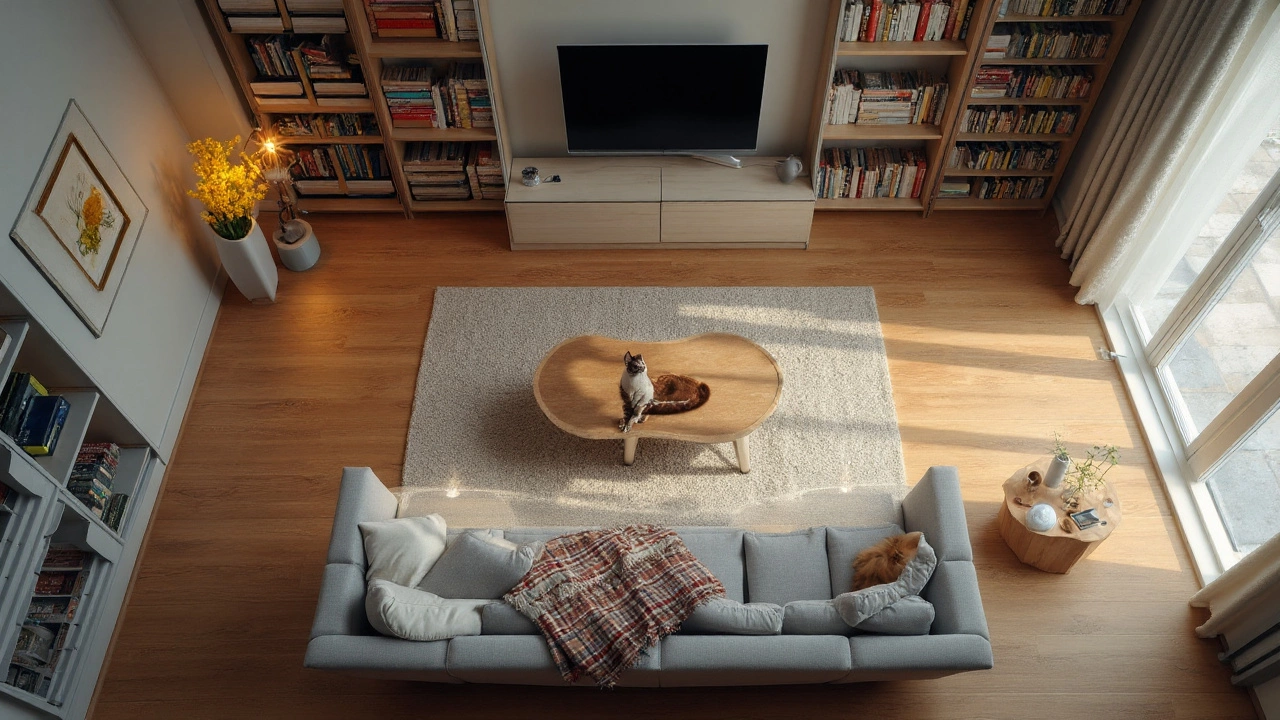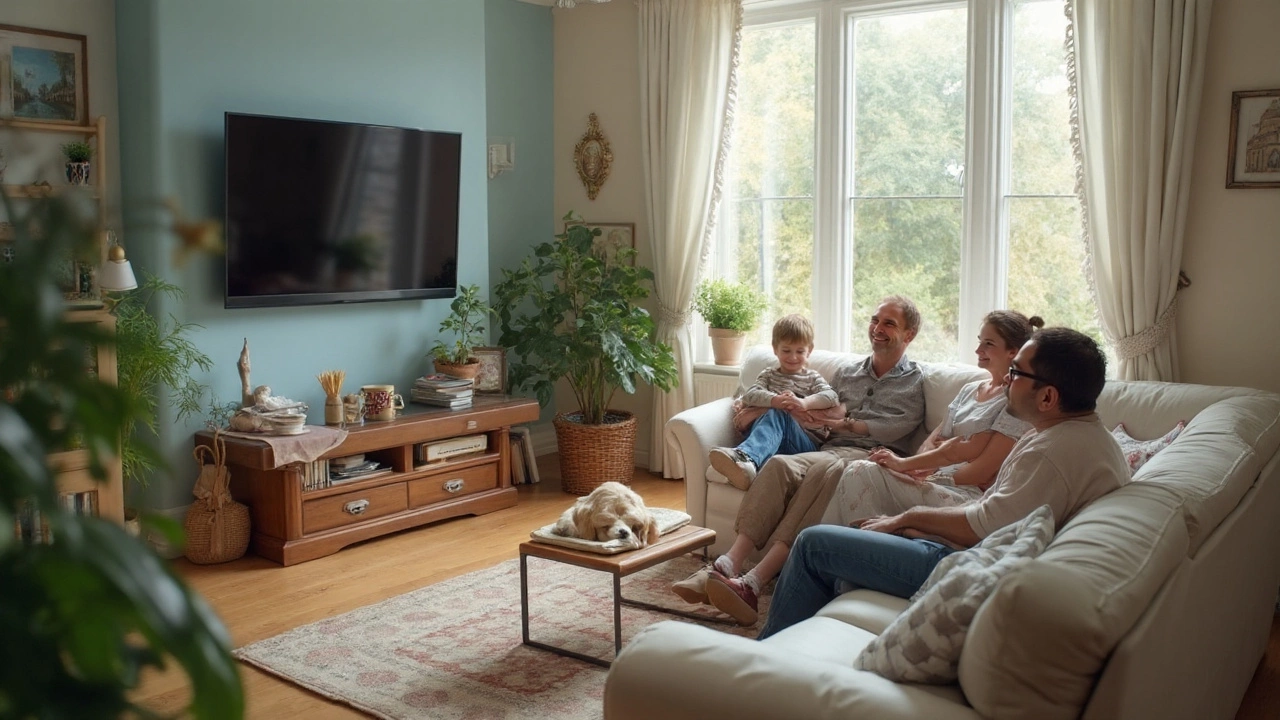Ever squinted at your TV, then inched your sofa back only to end up buried under a mountain of blankets with a crick in your neck? People spend hours binge-watching, yet so many live with the wrong viewing setup because no one told them there's actual math (and a little common sense) involved. The ideal distance between your sofa and TV isn’t just about comfort—it can protect your eyes, reduce headaches, and let's face it, save your relationships from arguments about who's hogging the good spot. While my cat Luna would be thrilled if I bought a 90-inch TV just for her chase scenes, most of us juggle screen size, room proportions, and real-life habits. Let’s break down what truly matters.
Why Distance Between Sofa and TV Matters
Most people think placing the sofa wherever it fits is fine, but slowing down to measure makes a dramatic difference. Your eyes have a field of view—too close, and you’re panning your head like you’re at a tennis match. Too far, and all that glorious 4K detail is wasted. According to the American Optometric Association, sitting the right distance from your TV cuts down on eye strain and stops that nagging headache after a film marathon. They suggest your eyes stay relaxed when the TV fills about a 30-degree angle of your view. In normal lingo: you shouldn’t need to move your head or squint. The TV manufacturers have their own numbers, and they shout them from the rooftops to sell bigger screens, but the core idea stays the same—match the size to your room and sofa placement.
There’s also the comfort factor. Ever tried watching a two-hour movie with a crick in your neck because your sofa is too close or too far? Nobody wins, not even the dog. And don’t forget: placing your TV too close can wear out your eyes faster, especially in lower lighting. Even if you’ve invested in the latest OLED wizardry, getting the viewing distance off means your picture quality is compromised—pixels are wasted, motion blur increases, and colors don’t pop like they should. Your pets may not care, but your eyes will.
One interesting thing: the early days of CRT TVs had way less resolution, so distance didn’t matter as much—you needed to sit back to blend those chunky pixels together. Now, ultra-high-res TVs beg you to sit up close (sometimes even closer than feels comfortable) because you can’t see individual pixels. That means modern homes with big wall-hogging screens have to consider both ergonomic and psychological effects—the right setup not only looks good but feels good.
There’s also glare and lighting. If your sofa’s too close, the angle between your eyes and reflected light from windows or lamps grows, which means more glare. The perfect spot helps avoid this by naturally angling your view so any reflections bounce away. Lastly, optimal spacing can make rooms look bigger—even a small living room gains separation and flow with a little sofa-to-TV breathing room. No more cramming the sofa right under the TV just because you saw it in a furniture brochure.
How to Calculate the Ideal Sofa to TV Distance
You might think there’s a universal answer, but it varies based on your TV’s size and type. Here’s the bit you’ve been waiting for: the simple formula. TV pros and groups like THX and the Society of Motion Picture and Television Engineers (SMPTE—that’s a mouthful, but yes, these are real TV scientists) suggest you multiply your TV’s diagonal size by about 1.2 to 1.5 to get the best viewing distance in inches for 4K TVs. For Full HD sets (1080p), you’ll want to sit further—roughly 1.5 to 2.5 times the diagonal.
Sounds like homework, but seriously, let’s see how it shakes out with a common size like a 65-inch TV (because everyone seems to want one these days):
| TV Size (inches) | Minimum Distance (4K, feet) | Maximum Distance (4K, feet) | Full HD (feet) |
|---|---|---|---|
| 50 | 5.0 | 6.3 | 6.3 – 10.4 |
| 55 | 5.5 | 6.9 | 6.9 – 11.5 |
| 65 | 6.5 | 8.1 | 8.1 – 13.5 |
| 75 | 7.5 | 9.4 | 9.4 – 15.6 |
Example time! For a 65-inch 4K TV, 6.5 to 8 feet is ideal. That covers most medium-sized living rooms. Still using a 1080p set? Slide that sofa back to at least 8 feet, and don’t go more than 13.5 feet away or the picture gets muddy. It’s about the sweet spot: you should see all the detail but not feel overwhelmed. Will your pets obey this law? Luna likes curling up closer to the screen, but Milo prefers the other end of the room. Your eyes deserve better than cat-level guesswork.
This is just the start—each room tweaks these numbers a bit. Low-slung sofas might need the TV mounted higher (which affects distance). Super-soft, deep-seat sofas push you back further, even if you didn’t plan on it. And don’t forget coffee tables. If your living room feels cramped, you can’t always place your sofa in “ideal” territory. But the closer you get, the better your whole viewing setup runs, and yes—your eyes, ears, and nerves will thank you. If you’re serious about the perfect home theater (or just the perfect Netflix binge), this step pays off every single night.

Common Mistakes and How to Avoid Them
You’ve probably seen the classic blunder: monster TV, tiny room, and a sofa so close you could high-five the news anchor. Or maybe you’ve got a small TV wall-mounted in a big living space, where you need binoculars just to check the sports score. The biggest trip-ups? Ignoring how resolution and room size factor in, letting aesthetics (instead of common sense) rule, or following “rules of thumb” without measuring. One friend put her new 75-inch UHD TV where an old 32-incher used to be—looked sharp, but she ended up standing at the doorway to take it all in. Don’t do this to yourself.
Some folks push their sofa tight against the back wall to “open up” space, but that can make even a decent-sized living room feel like a bowling alley, and it cheats you out of the right viewing angle. Others stick to a layout just because they saw it on Instagram, even if it means contorting their neck for every episode. I’ll admit, I once angled my TV to fit a stubborn shelf and spent months wondering why my back hurt after every Breaking Bad session. Moving the sofa solved it instantly (and gained me a new favorite nap spot, at least according to Luna).
Lighting also messes things up more than you’d expect. If you plop your sofa in a sunny spot, glare can turn that fancy display into a frustration zone. I know a guy who put blackout curtains in his living room just because the sun kept ruining his afternoon movies. Fixing the orientation or shifting the sofa just a foot or two often does the trick.
It’s tempting to ignore TV height, but that’s another place folks go wrong. Eyes should hit the center of the screen when you’re relaxed—not staring upward like you’re in the front row at a bad cinema. Mark the wall if you have to. Even Milo, not known for his interior design sense, knows the best seat is one where you can actually watch—not strain, squint, or sigh.
Imagine you’re rearranging for a game night or a movie party. Flexible setups (like using lightweight loveseats, poufs, or moveable recliners) can keep your room functional without sacrificing that movie-theater feeling. What’s the point of nailing the math if nobody’s comfortable or has a place to put their snacks? Sometimes, it’s about balancing the textbook answer with the way families really use their living spaces. Never think you’re stuck with a layout just because a design magazine said so—or because your cat’s favorite spot says you can’t.
Practical Tips and Real-Life Solutions
If you’re ready to shake up your living room, start simple. Grab a tape measure, and check the sofa-to-TV distance based on your TV’s size and resolution. Don’t sweat perfection, but aim to get within the recommended range. For smaller rooms, wall-mounting the TV (with a slight downward tilt) can save precious inches and free up floor space, keeping the right distance even with bulky sofas. Adjustable mounts work wonders if you have multiple seating zones or like changing things up. If you can’t shift the entire sofa, try angling chairs or adding an ottoman to create extra, comfortable options that hit the target spot.
Sound matters, too. Your perfect visual distance might mess with acoustics. If your TV speakers feel muffled or echoey, consider adding a soundbar or small speakers. Position them at ear level for the best experience—audio should be as immersive as the picture. I learned this the hard way after Luna parked herself right in front of a speaker during movie night, muffling every crash and boom from the screen. Lesson learned: plan for both eyes and ears.
If you’re redecorating, build the room around your sofa-to-TV setup, not the other way around. Choose a sofa depth that matches your preferred viewing spot. For larger families, U-shaped setups or sectional sofas can help everyone get the “prime” spot, not just whoever claims it first. Pet owners—yes, I see you—keep in mind where your furry pals love to nap. My dog Milo tends to sprawl right between the sofa and TV, so we keep extra dog beds off to the side to stop him playing speed bump. Design your room for the way you actually use it—not just how it looks on a floor plan.
Don’t forget about decor. Use rugs and tables to subtly “anchor” your sofa in the right place. Tall plants or shelves behind the sofa make the space look intentional even if you need to float the seating off the wall for the best view. Lighting is your friend—avoid overhead glare, use dimmable side lamps, and, if you want to splurge, grab some bias lighting (LED strips behind the TV) to reduce contrast and keep things easier on your eyes.
Big or small, your living room works better when comfort and tech meet in the middle. Play around, use the math, but don’t forget to adjust for the quirks—who sits where, which corner gets the best breeze, where your dog likes to snooze. People (and pets) move around far more than Room Designer apps predict. Your best spot is one that keeps everyone—and every set of eyes—happy. The magic’s in those few feet between sofa and screen. Find yours—and enjoy it.


Write a comment